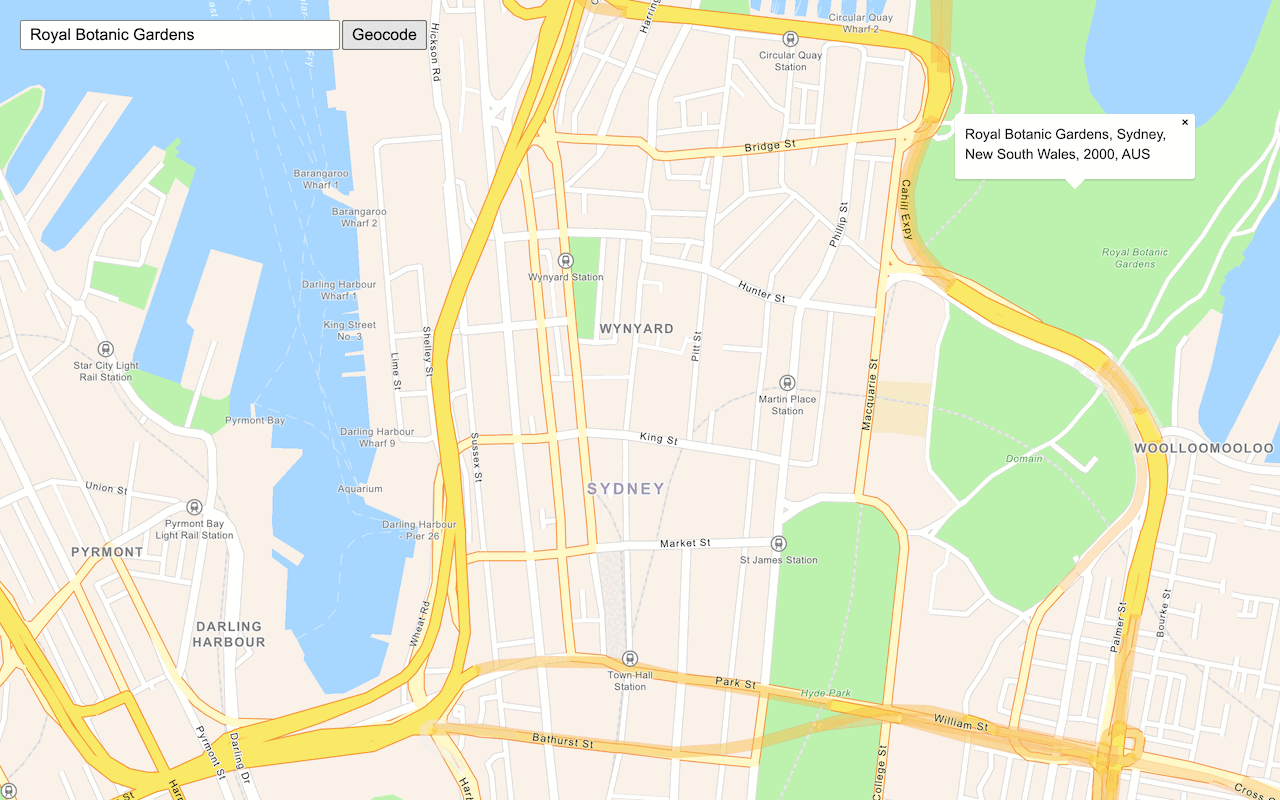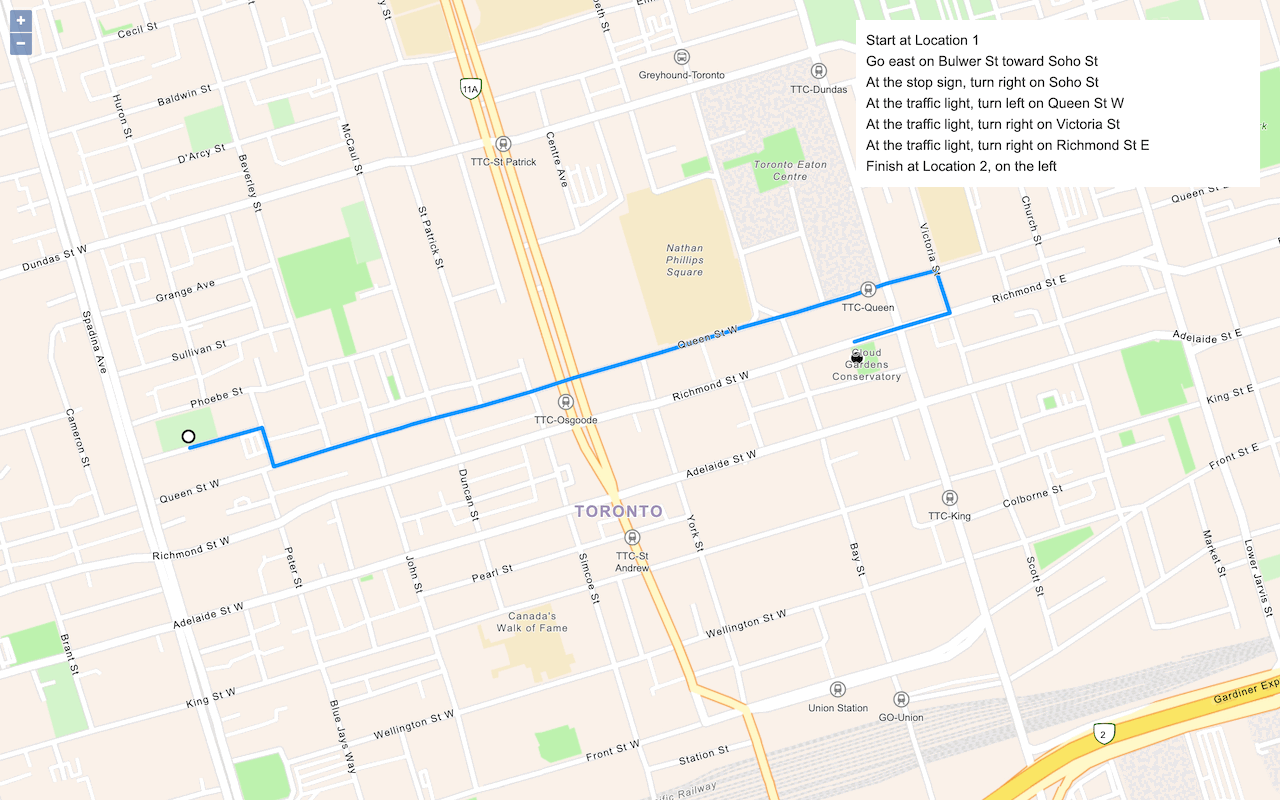Learn how to calculate the area that can be reached in a given driving time from a location.
A service area, also known as an isochrone, is a polygon that represents the area that can be reached when driving or walking on a street network. The area that can be reached is restricted by either time or distance. To calculate service areas, you can use the routing service. You provide a start location (facilities), one or more time or distance values, and a spatial reference. Once processed, the service returns the service areas that can be reached.
In this tutorial, you create and display five, ten, and fifteen minute drive time service areas when the map is clicked. You use data-driven styling to give each polygon a different shade of blue.
Prerequisites
An ArcGIS Location Platform or ArcGIS Online account.
Steps
Get the starter app
Select a type of authentication below and follow the steps to create a new application.
Set up authentication
Create developer credentials in your portal for the type of authentication you selected.
Set developer credentials
Use the API key or OAuth developer credentials so your application can access location services.
Add references to ArcGIS REST JS
-
Reference the
routingandrequestpackages from ArcGIS REST JS.Use dark colors for code blocks <!-- Load Leaflet from CDN --> <link rel="stylesheet" href="https://unpkg.com/leaflet@1.9.4/dist/leaflet.css" crossorigin="" /> <script src="https://unpkg.com/leaflet@1.9.4/dist/leaflet.js" crossorigin=""></script> <!-- Load Esri Leaflet from CDN --> <script src="https://unpkg.com/esri-leaflet@3.0.14/dist/esri-leaflet.js"></script> <script src="https://unpkg.com/esri-leaflet-vector@4.2.7/dist/esri-leaflet-vector.js"></script> <!-- Load ArcGIS REST JS from CDN --> <script src="https://unpkg.com/@esri/arcgis-rest-request@4/dist/bundled/request.umd.js"></script> <script src="https://unpkg.com/@esri/arcgis-rest-routing@4/dist/bundled/routing.umd.js"></script>
Update the map
A navigation basemap layer is typically used in geocoding and routing applications. Update the basemap layer to use arcgis/navigation.
-
Update the basemap and the map initialization to center on location
[100.5231,13.7367], Bangkok.Use dark colors for code blocks /* Use for API key authentication */ const accessToken = "YOUR_ACCESS_TOKEN"; // or /* Use for user authentication */ // const session = await arcgisRest.ArcGISIdentityManager.beginOAuth2({ // clientId: "YOUR_CLIENT_ID", // Your client ID from OAuth credentials // redirectUri: "YOUR_REDIRECT_URI", // The redirect URL registered in your OAuth credentials // portal: "YOUR_PORTAL_URL" // Your portal URL // }) // const accessToken = session.token; const basemapEnum = "arcgis/streets"; const map = L.map("map", { minZoom: 2 }); map.setView([13.7367, 100.5231], 13); // Bangkok L.esri.Vector.vectorBasemapLayer(basemapEnum, { token: accessToken }).addTo(map);
Add layer groups
In this app, you display a marker for the starting point location and polygons for the service areas. Add a Layer to display the point and polygons on the map.
-
Add a
Layerfor theGroup clickedand another for thePoint service.Areas Use dark colors for code blocks L.esri.Vector.vectorBasemapLayer(basemapEnum, { token: accessToken }).addTo(map); const clickedPoints = L.layerGroup().addTo(map); const serviceAreas = L.layerGroup().addTo(map);
Add a click handler
When you click on the map, you will update the location of the clicked and return a new service area.
-
Add a
clickevent handler. Inside, remove the data from the previous click withclear.Layers Use dark colors for code blocks const clickedPoints = L.layerGroup().addTo(map); const serviceAreas = L.layerGroup().addTo(map); map.on("click", (e) => { clickedPoints.clearLayers(); serviceAreas.clearLayers(); }); -
Display a
Markerat the clicked location.Use dark colors for code blocks map.on("click", (e) => { clickedPoints.clearLayers(); serviceAreas.clearLayers(); L.marker(e.latlng).addTo(clickedPoints); });
Get the service area
With the longitude and latitude of the click event, you can call the service function from ArcGIS REST JS to get the service area.
-
Create a new
Apito access the route service.Key Manager Use dark colors for code blocks const clickedPoints = L.layerGroup().addTo(map); const serviceAreas = L.layerGroup().addTo(map); const authentication = arcgisRest.ApiKeyManager.fromKey(accessToken); map.on("click", (e) => { clickedPoints.clearLayers(); serviceAreas.clearLayers(); L.marker(e.latlng).addTo(clickedPoints); }); -
Call the
serviceoperation. Set theArea facilitiesparameter with the clicked coordinates to calculate the service area.The
facilitiesparameter lets you pass in multiple locations around which the service area is calculated. In this case, you are only passing one.By default, the three drive times that are requested are 5, 10 and 15 minutes. You can change these by passing the
defaultparameter.Breaks Use dark colors for code blocks const authentication = arcgisRest.ApiKeyManager.fromKey(accessToken); map.on("click", (e) => { clickedPoints.clearLayers(); serviceAreas.clearLayers(); L.marker(e.latlng).addTo(clickedPoints); arcgisRest .serviceArea({ endpoint: "https://route-api.arcgis.com/arcgis/rest/services/World/ServiceAreas/NAServer/ServiceArea_World/solveServiceArea", authentication, facilities: [[e.latlng.lng, e.latlng.lat]] }) }); -
Add an error handler. Inside, show a message and write the error to the console.
Use dark colors for code blocks arcgisRest .serviceArea({ endpoint: "https://route-api.arcgis.com/arcgis/rest/services/World/ServiceAreas/NAServer/ServiceArea_World/solveServiceArea", authentication, facilities: [[e.latlng.lng, e.latlng.lat]] }) .catch((error) => { console.error(error); alert("There was a problem using the route service. See the console for details."); });
Display the service area on the map
The response to the request contains the geographic information of the service areas that you can access and display on the map.
-
Add a response handler. Inside, add a
Geolayer that adds the features to theJSON servicelayer.Areas Use dark colors for code blocks arcgisRest .serviceArea({ endpoint: "https://route-api.arcgis.com/arcgis/rest/services/World/ServiceAreas/NAServer/ServiceArea_World/solveServiceArea", authentication, facilities: [[e.latlng.lng, e.latlng.lat]] }) .then((response) => { L.geoJSON(response.saPolygons.geoJson, { } ).addTo(serviceAreas); }) .catch((error) => { console.error(error); alert("There was a problem using the route service. See the console for details."); }); -
Style the different polygons using the
Fromproperty to distinguish the 5, 10, and 15 minute drive time polygons.Break Use dark colors for code blocks .then((response) => { L.geoJSON(response.saPolygons.geoJson, { style: (feature) => { const style = { fillOpacity: 0.5, weight: 1 }; if (feature.properties.FromBreak === 0) { style.color = "hsl(210, 80%, 40%)"; } else if (feature.properties.FromBreak === 5) { style.color = "hsl(210, 80%, 60%)"; } else { style.color = "hsl(210, 80%, 80%)"; } return style; } } ).addTo(serviceAreas); })
Run the app
Run the app.
When you click on the map, three service areas are shown as concentric polygons around a marker. These indicate the areas that can be reached by driving for 5, 10 or 15 minutes.What's next?
Learn how to use additional ArcGIS location services in these tutorials:


